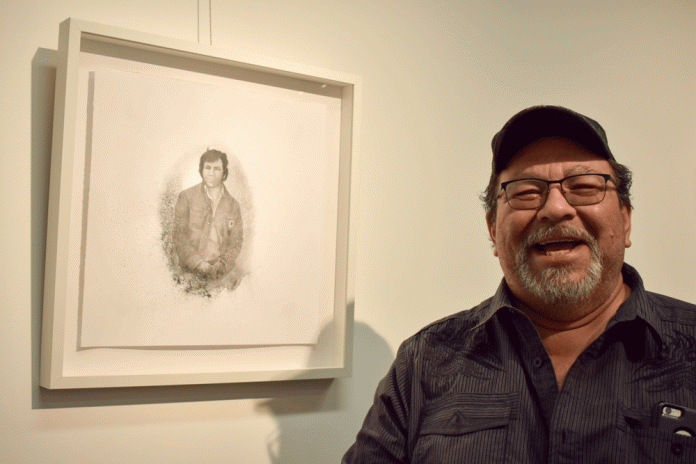M’CHIGEENG—The modern architectural form of the Ojibwe Cultural Foundation (OCF), fully situated in the present, pays homage to the everlasting traditions of the Anishinaabek—the Odawa, Ojibwe and Potawatomi of Manitoulin Island and the Great Lakes region.
Light permeates the open circular atrium that forms the heart of the entryway and of the building itself. Towering cedar poles buttress the room’s soaring canopy, lifting the spirit in the upward gaze. Activities radiate likes spokes from a wheel in offices, a large workshop and activities area, a Healing Lodge, also circular, that holds a sacred fire for ceremonies, Ojibwe language radio station CHYF-FM and a museum that reflects on the inexorable links between traditional creative expression and modern manifestations of Anishinaabek art.
Upon entering the OCF’s museum, a large dreamcatcher bathed in soft spotlight compels the visitor to consider the meanings it conjures. Originally crafted by Ojibwe mothers to protect sleeping children from harm, the dreamcatcher still acts as a symbolic filter, trapping evil and letting good flow through wherever it is hung. This dreamcatcher, in forged steel by M’Chigeeng steelworker artist Kathryn Corbiere, evokes the traditional uses and construction of this beloved cultural emblem, but seems imbued with even more than the usual resistance in its use of materials, perhaps in response to increasing modern threats to the environment, and thus to identity and way of life. A beautiful work of art, Ms. Corbiere’s Dreamcatcher is hung near the museum’s entry doors, a powerful sentinel, a steely reminder of what endures, its metal web perhaps shredding malevolent spirits to bits, allowing only positivity to pass into the museum experience beyond. It’s immediately the sort of cultural encounter that is repeated throughout the exhibits in myriad inspired forms.
“Anishinaabek art history is one of incorporating new materials, of playing with materials in continually re-interpreting traditional art forms,” says OCF Executive Director Anong Migwans Beam, who is a member of M’Chigeeeng First Nation and a widely exhibited multi-media artist.
We pause before two glass cases, each displaying an elaborately beaded1870s ‘bandolier bag’ gifted to the OCF; with a flat bag in front conceived “to show off a big panel of beaded design,” according to Ms. Beam, the bandolier has a wide beaded strap diagonally crossing the chest to one shoulder.
Anishinaabe bandolier bags, modeled on rifle bags worn by Europeans, “evolved with increasing trade in the Great Lakes region and the acquisition of new materials such as cotton and wool cloth, beads and ribbons.” The tiny glass ‘seed beads,’ sewn densely in elaborate patterns onto cotton, wool or hide backing by the women, carpeted the bags in symbolic imagery and dazzling colour to be worn ceremonially by the men. “Beads allowed for curves in patterns where before, the use of quills did not,” says Anong Beam. “The signature floral patterns on these bags were made possible by the flexibility of the newly available materials.”

photo by Isobel Harry
Beyond the antique bags, another bag is displayed close by, ‘beaded’ by contemporary artist Barry Ace, using salvaged computer components and copper wire to form complex floral motifs based on traditional designs. Says the artist: “I am referencing Anishinaabeg beadwork as a metaphor for cultural continuity, bridging the past with the present and the future, and as a demonstrable act of nationhood, resistance and modernity. My contemporary practice intentionally, yet respectfully, transcends and moves forward conventional Anishinaabeg cultural boundaries as a confluence between the historical and contemporary.”
Confluence is felt in all the Museum’s exhibits: in the art of Christian Chapman, entitled ‘Kings and Queens,’ that fuses silkscreen onto Woodlands-style paintings, in the traditional jingle dress side by side with one silkscreened all over in small faces, in the quill box made by Mamie Migwans and designed by Carl Beam (“she was the first to use toned-down colours in quill work,” says Anong) and in the large display of contemporary quill, black ash and textile art by members of today’s community next to a wall-size interactive introduction to Anishinaabe life precepts.
Anong Beam scans the visually evocative space: “With Anishinaabe art, there is a constant push for new expression. The push comes from a desire to build bridges between traditional and contemporary expressions, to show them together in a continuum of creativity.”
Ojibwe Cultural Foundation: 15 Hwy 551, M’Chigeeng, Tel: 705-377-4902. Open Monday to Friday 8:30 am to 4 pm; Saturday 10 am to 4 pm. Admission by donation. https://ojibweculture.ca
A stone’s throw from the OCF, around the corner and east on Hwy 540, is the unmissable Lillian’s Museum, a dedicated space attached to Lillian’s Crafts’ large shop that holds owner Lillian Debassige’s prized 70-odd-year-old collection of Anishinaabe arts and crafts.
A big room is arrayed from floor to ceiling in unique pieces of local Anishinaabe art dating back to the 1940s: rare ash baskets woven with consummate dexterity and intricate quill boxes with lifelike animals and plants tufted in quills by artists Anne Pangowish, Rose Williams, Josette Debassige, Mildred and Melanie Aguonie and many others whose work is preserved here for posterity.
The distinctive and highly collectable paintings of Wiikwemkoong artist Leland Bell line the back wall; ceramic bowls, beaded hide moccasins with fur trim and skillful carvings of antler and bone, going back many decades, line glass cases. Lillian’s collection is far reaching but intimate, inviting viewers to appreciate the age-old techniques, materials and designs used in the creation of these cultural treasures.
Lillian’s Museum: 5950 Hwy. 540, M’Chigeeng, Tel.: 705-377-4987. Hours: Monday to Friday, 9 am to 6 pm; Saturday 9 am to 5 pm; Sunday 10 am to 5 pm. Admission by donation. http://lilliansindiancrafts.com





